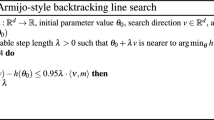Abstract
How can the basic compatibility of theory and observations be investigated for nonlinear processes without requiring stochastic characterizations for residual error terms? The present paper proposes a flexible least-cost approach. For each possible estimatex for the sequence of process states, letc D (x) andx M(x) denote the costs incurred for deviations away from the prior dynamic specifications and prior measurement specifications, respectively. Define the cost-efficiency frontier to be the greatest lower bound for the set of all possible cost pairs [c D (x),c M(x)], conditional on the given observations. State sequence estimatesx that attain the cost-efficiency frontier indicate the possible ways that the actual process could have developed over time in a manner minimally incompatible with the prior dynamic and measurement specifications. An algorithm is developed for the exact sequential updating of the cost-efficient state sequence estimates as the duration of the process increases and additional observations are obtained.
Similar content being viewed by others
References
Kalaba, R., andTesfatsion, L.,Flexible Least Squares, Working Paper No. M8616, Modelling Research Group, Department of Economics, University of Southern California, 1986.
Kalaba, R., andTesfatsion, L.,Time-Varying Regression Via Flexible Least Squares, Computers and Mathematics With Applications, Vol. 17, 1989 (in press).
Kalaba, R., Rasakhoo, N., andTesfatsion, L.,A FORTRAN Program for Time-Varying Linear Regression Via Flexible Least Squares, Computational Statistics and Data Analysis, Vol. 7, 1988 (in press).
Bellman, R., Kagiwada, H., Kalaba, R., andSridhar, R.,Invariant Imbedding and Nonlinear Filtering Theory, Journal of the Astronautical Sciences, Vol. 13, pp. 110–115, 1966.
Detchmendy, D., andSridhar, R.,Sequential Estimation of States and Parameters in Noisy Nonlinear Dynamical Systems, Journal of Basic Engineering, Vol. 88, pp. 362–368, 1966.
Kagiwada, H., Kalaba, R., Schumitsky, A., andSridhar, R.,Invariant Imbedding and Sequential Interpolating Filters for Nonlinear Processes, Journal of Basic Engineering, Vol. 91, pp. 195–200, 1969.
Bellman, R., andKalaba, R.,Quasilinearization and Nonlinear Boundary-Value Problems, Elsevier, New York, New York, 1965.
Sugisaka, M., andSagara, S.,A Nonlinear Filter with Higher-Order Weight Functions via Invariant Imbedding, International Journal of Control, Vol. 21, pp. 801–823, 1975.
Kalaba, R., andTesfatsion, L.,An Exact Sequential Solution Procedure for a Class of Discrete-Time Nonlinear Estimation Problems, IEEE Transactions on Automatic Control, Vol. AC-26, pp. 1144–1149, 1981.
Kalaba, R., Spingarn, K., andTesfatsion, L.,A Sequential Method for Nonlinear Filtering: Numerical Implementation and Comparisons, Journal of Optimization Theory and Applications, Vol. 34, pp. 541–559, 1981.
Kalaba, R., andTesfatsion, L.,A Least-Squares Model Specification Test for a Class of Dynamic Nonlinear Economic Models with Systematically Varying Parameters, Journal of Optimization Theory and Applications, Vol. 32, pp. 538–567, 1980.
Kalaba, R., andSpingarn, K.,Control, Indentification, and Input Optimization, Plenum, New York, New York, 1982.
Kalaba, R., andTesfatsion, L.,Exact Sequential Filtering, Smoothing, and Prediction for Nonlinear Systems, Nonlinear Analysis, Theory, Methods, and Applications, Vol. 12, pp. 599–615, 1988.
Abutaleb, A.,New Results in Sridhar Filtering Theory, Journal of the Franklin Institute, Vol. 32, pp. 229–238, 1986.
Hildreth, C.,The Cowles Foundation in Chicago, 1939–1955, Springer-Verlag, New York, New York, 1986.
Mansur, A., andWhalley, J.,Numerical Specification of Applied General Equilibrium Models: Estimation, Calibration, and Data, Applied General Equilibrium Analysis, Edited by H. Scarf and J. Shoven, Cambridge University Press, Cambridge, England, pp. 69–127, 1984.
Shoven, J., andWhalley, J.,Applied General-Equilibrium Models of Taxation and International Trade, Journal of Economic Literature, Vol. 22, pp. 1007–1051, 1984.
Blatt, J. M.,On the Econometric Approach to Business-Cycle Analysis, Oxford Economic Papers, Vol. 30, pp. 292–300, 1978.
Day, R.,The Emergence of Chaos from Classical Economic Growth, Quarterly Journal of Economics, pp. 201–213, 1983.
Brock, W.,Distinguishing Random and Deterministic Systems: Abridged Version, Journal of Economic Theory, Vol. 40, pp. 168–193, 1986.
Barnett, W., andChen, P.,The Aggregation-Theoretic Monetary Aggregates Are Chaotic and Have Strange Attractors, Dynamic Econometric Modelling, Edited by W. Barnett, E. Berndt, and H. White, Cambridge University Press, Cambridge, England, 1988 (in press).
Engle, R.,Wald, Likelihood Ratio, and Lagrange Multiplier Tests in Econometrics, Handbook of Econometrics, Vol. 2, Edited by Z. Griliches and M. Intriligator, Elsevier, Amsterdam, The Netherlands, 1984.
Ruud, P. A.,Tests of Specification in Econometrics, Econometric Reviews, Vol. 3, pp. 211–242, 1984.
Huber, P.,The Behavior of Maximum Likelihood Estimates under Nonstandard Conditions, Proceedings of the 5th Berkeley Symposium on Mathematical Statistics and Probability, Vol. 1, Edited by L. M. LeCan and J. Neyman, University of California Press, Berkeley, California, 1967.
Tauchen, G.,Diagnostic Testing and Evaluation of Maximum Likelihood Models, Journal of Econometrics, Vol. 30, pp. 415–443, 1985.
Zellner, A.,Bayesian Econometrics, Econometrica, Vol. 53, pp. 253–269, 1985.
Leamer, E.,Specification Searches, John Wiley and Sons, New York, New York, 1978.
Hampel, F., Ronchetti, E., Rosseeuw, P., andStahel, W.,Robust Statistics, John Wiley and Sons, New York, New York, 1986.
Tukey, J.,Exploratory Data Analysis, Addison-Wesley, Reading, Massachusetts, 1977.
Craven, P., andWahba, G.,Smoothing Noisy Data with Spline Functions, Numerische Mathematik, Vol. 31, pp. 377–403, 1979.
Rice, J., andRosenblatt, M.,Smoothing Splines: Regression, Derivatives, and Deconvolution, Annals of Statistics, Vol. 11, pp. 141–156, 1983.
Author information
Authors and Affiliations
Additional information
A preliminary version of this paper (Ref. 1) was presented at the June 1986 Summer Econometric Society Meeting at Duke University. The authors are grateful to I. Adelman, E. Massoumi, S. Mittnik, H. C. Quirmbach, A. Zellner, and especially to R. Huss for helpful comments.
Rights and permissions
About this article
Cite this article
Kalaba, R., Tesfatsion, L. Sequential nonlinear estimation with nonaugmented priors. J Optim Theory Appl 60, 421–438 (1989). https://doi.org/10.1007/BF00940346
Issue Date:
DOI: https://doi.org/10.1007/BF00940346




